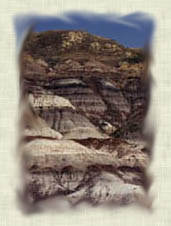
SUPERB SPANISH DINOSAUR TRACKS - AND A GIANT STEP FORWARD FOR FLOOD GEOLOGY!
Flood Geology in the field
It has become apparent in recent years that the best dinosaur tracks in Europe are to be found in the Rioja region of Northern Spain. Where better then, to have a creationist excursion? - to work through some of the issues being discussed by geologists who believe that the Genesis Flood was a world-wide event, unparalleled in all history.
Dinosaurs and their tracks have excited in the minds of adults and children alike, and the extraordinary evidences related to their extinction have kept people's interest for decades. But how are Christians to understand these evidences? And how can we translate our understanding into something which is robust enough to stand against the critical analysis of geologists who say the Bible records nothing of relevance to their discipline?
During October 1996, a remarkable excursion was led by Michael Garton and Steven Robinson (names already familiar to readers of Origins). The first day in the field was designed to recognise the local geological column, which was described primarily in terms of rock type. Members of the party had plenty of opportunity to examine the rocks and to note similarities and differences between the different units. (There were actually two excursions, and I was a member of the second group). The most spectacular part of this day (speaking for myself) was the dramatic thrust plane which marked a shortening movement of some 20-25 km between two large crustal plates. There were plenty of evidences of forces powerful enough to crush rocks to dust, combined with indications that water was present to facilitate movement at the junction of the two thrust blocks. What was particularly striking was the way the overthrust block had over-ridden an enormous pile of broken pieces of rock that had been eroded from the overthrust block. Here, older rocks were very obviously thrust over younger rocks.
By this stage, all members of our party were convinced that it is meaningful to talk about the geological history of an area. For example, rock types A and B were deposited, altered by heat, folded and eroded; rock types C and D were deposited; overthrusting occurred accompanied by much contemporaneous erosion; rock types E and F were deposited; etc. By reasoning along these lines, we were able to locate the dinosaur trackways in the sequence and consider events before and after the tracks were formed.
The second day had a geological focus on the dinosaurs which somehow harmonised very well with the time spent in corporate worship and prayer. The mechanism of forming the tracks, the very limited horizons of occurrence, and the characteristics of the surrounding rocks were all discussed. It became apparent that the tracks were formed on flat-lying sediment, which was sometimes drying out and sometimes under shallow water. It followed that the dinosaurs would not have been content as they walked around - their world was a wasteland with nowhere to shelter or rest.
The final part of the trip was a 2-hour debriefing, where we were reminded of the observations we had made and where we were helped to put everything together into a coherent story. A number of alternative Flood models were considered, and we were asked to assess which was more compatible with the evidence we had seen. Most of the controversial issues within Flood Geology were addressed helpfully by reference to evidences seen during the weekend. We considered whether the Geological Column is a useful concept; whether large-scale overthrusting has occurred; and whether it is possible to reconstruct the geological history of a region with reference to the Flood and biblical history.
The answers that did emerge during the weekend were different from those presented in many creationist books. For example, the Geological Column was found to be a defensible and useful concept; overthrusting was recognised as a real phenomenon and not an invention of evolutionists to explain away "out of sequence" strata; the pattern of fossils in local columns cannot be explained by saying that mobile animals fled to high ground during the early stages of the Flood - so the dinosaur footprints were not made by animals trying to escape rising flood waters. The implications are very far-reaching. At very least, many creationist books are in need of urgent revision. Much work is needed to establish Flood Geology on firmer ground - and this weekend represents (in my view) a giant step forward for creation-based geology.
Do you want to find out more? You can do this by reading Michael Garton's series of articles in the BCS journal Origins. But if you really want to work through these issues in the field, contact BCS at its postal address, to find out about any future trips that are planned.
David J. Tyler (November 1996)

